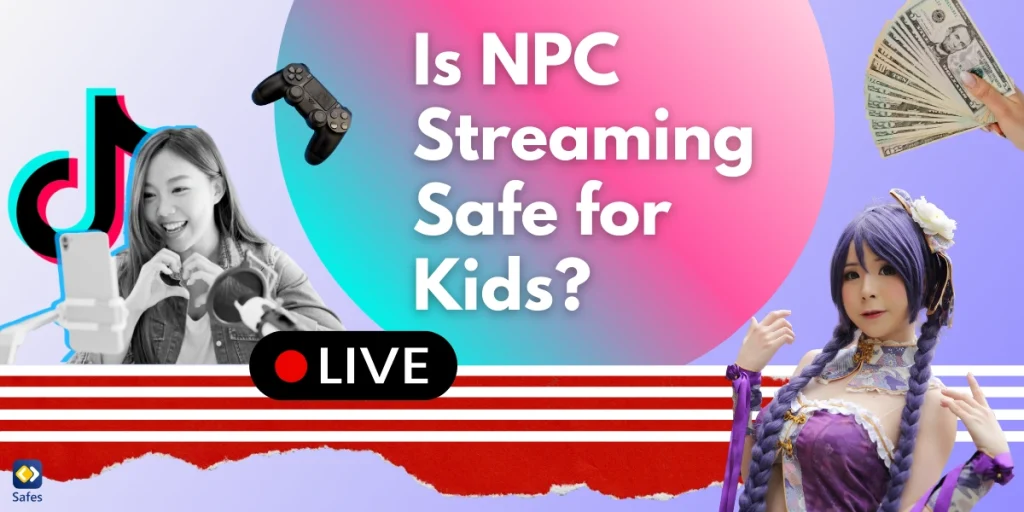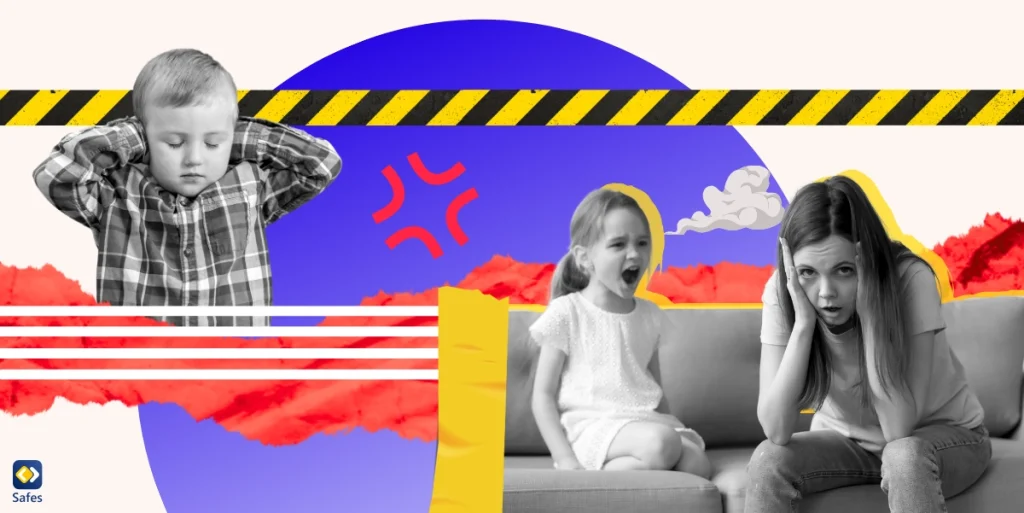NPC streaming, the latest trend on platforms like TikTok, involves creators performing robotic, repetitive actions, similar to non-playable characters (NPCs) in video games. Popular among younger audiences, NPC streaming can be humorous or even surreal, as viewers send gifts to trigger specific actions or phrases from streamers. While intriguing and entertaining for many, NPC streaming has sparked concerns about the safety and psychological effects of this trend, particularly for children and teens who are active on TikTok. In this blog post, we’ll explore what NPC streaming is, why it appeals to young audiences, and examine the potential safety concerns surrounding it.
Download and Start Your Free Trial of the Safes Parental Control App
What Is NPC Live Streaming?
The meaning of NPC streaming is a TikTok genre where content creators act as though they’re NPCs from video games. They maintain robotic expressions, engage in repetitive actions, and say pre-scripted phrases in response to viewer actions, such as sending virtual gifts. TikTok viewers buy these gifts with real money, prompting a specific reaction from the streamer. The interactivity, combined with the creators’ carefully maintained, “lifeless” demeanor, makes the experience unique and sometimes comical.
For example, creators like PinkyDoll and Cherry Crush are well-known in this niche for saying lines such as “Ice cream so good” or “Gang, gang!” when triggered by certain emojis. Viewers enjoy feeling like they have “control” over the streamer’s actions, much like controlling a video game character
Why are NPC Streams So Popular Among Kids and Teens?
Here’s why NPC live streams are so popular with kids and teens:
- Interactivity: NPC streaming is highly interactive, making viewers feel involved. Young audiences enjoy being part of the experience, triggering actions, and watching how their virtual gifts shape the streamer’s behavior.
- Humor and Novelty: Many children and teens find humor in the absurdity of NPC streaming. The robotic responses, combined with quirky phrases, provide a unique form of entertainment. Additionally, it’s a new and novel form of engagement on social media, setting it apart from more typical live-streaming content.
- Social Influence: With viral creators in the NPC streaming genre, younger audiences may feel pressured to join the trend or consume this type of content to stay current with popular culture.

Safety Concerns with NPC Streaming for Kids
Although NPC streaming appears humorous and entertaining, several safety concerns arise, especially when young children and teens are the primary audience.
1. Financial Exploitation
NPC streamers make money from virtual gifts, and this revenue model can lead young viewers to spend money, sometimes excessively. TikTok tokens, which are used to buy these virtual gifts, cost real money, and the impulsive nature of NPC streaming can lead children to purchase tokens in the heat of the moment. Parents may not always be aware of these purchases, which can result in unexpected charges and poor spending habits for young viewers.
2. Risk of Imitating Content
As NPC streaming grows in popularity, some younger users may feel pressured to emulate this behavior to gain views or popularity. The repetitive, robotic behaviors and nonsensical phrases that characterize NPC streaming might encourage imitation, potentially leading children to create similar content that could expose them to online exploitation. Acting in a robotic or emotionless way may make them more susceptible to harmful comments or engagement, especially from strangers.
3. Inappropriate Content Exposure
Although most NPC streaming appears harmless, there are instances where this genre crosses into suggestive or adult themes. Some NPC streamers use provocative or ambiguous language to attract viewers, which can be inappropriate for children. This content can expose young audiences to topics or interactions beyond their age-appropriate understanding, and may also connect them with adult viewers in public comment sections.
4. Nature of NPC Streaming
The repetitive, detached actions in NPC streaming may have subtle psychological effects, especially on younger viewers. Constant exposure to robotic behaviors could affect emotional development or desensitize children to more genuine human interactions. In a world where digital interactions are already commonplace, this genre may normalize detachment and lower empathy among younger viewers who consume this content regularly.
Furthermore, because the nature of NPC streaming depends on viewer engagement, the culture surrounding it may inadvertently promote attention-seeking behavior in children, influencing them to prioritize online engagement over genuine social interactions.
5. Privacy and Data CC
Streaming may expose young viewers to privacy risks. Since interactions are public, there is potential for children to share personal information inadvertently. Additionally, TikTok’s algorithm encourages users to engage with content similar to what they already view. This means that a child who interacts frequently with NPC streaming content could continue to receive more of the same, creating an echo chamber that reinforces the genre’s themes and making it difficult to explore other interests safely.
How Parents Can Manage Children’s Exposure to NPC Streaming
If your child is active on TikTok or other social media platforms where NPC streaming is prevalent, consider taking these steps to manage their exposure:
- Discuss NPC Streaming with Your Child: Open communication is essential. Explain what NPC streaming is, and ask your child how they feel about it. This helps prevent kids from hiding TikTok from you. This approach can help them process the content they’re viewing and understand any potential risks.
- Limit Screen Time: Restricting the amount of time your child spends on TikTok can help reduce exposure to NPC streaming content and prevent TikTok addiction. Establishing healthy screen time limits will encourage balanced use of digital media.
- Enable Parental Controls on TikTok: TikTok offers some parental control features, such as restricted mode and screen time limits. Enabling these features can help control the type of content your child sees and prevent overexposure to trends like NPC streaming. You can also use TikTok trackers.
- Monitor Purchases on Social Media Apps: Be vigilant about any spending linked to TikTok or similar apps. Ensuring your child understands that virtual gifts cost real money can help prevent impulsive purchases.
- Encourage Alternative Activities: Encourage offline activities, hobbies, and social interactions to balance your child’s online and offline experiences. Physical activities, reading, or creative hobbies can provide them with fulfilling ways to spend time outside of social media.
- Discuss Privacy and Online Safety: NPC streaming often involves public interaction, which may expose children to risks. Educating your child about maintaining privacy and avoiding oversharing can help them navigate online spaces safely.
Conclusion
NPC streaming’s combination of humor and interactivity has captivated young audiences, but it comes with significant safety concerns that parents need to address. From financial risks and privacy concerns to psychological impacts, the implications of NPC streaming are complex. By understanding the trend and taking proactive steps, parents can help ensure their children engage in safer, healthier digital experiences. Ultimately, open discussions and responsible digital habits are key to keeping kids safe in a world where trends like NPC streaming continue to evolve.
Take control of your child’s digital safety with Safes Family. From screen time limits to content filters, Safes Family equips parents with tools to manage and protect their child’s online experiences. Try Safes Family’s free trial today and create a safer online environment for your family. You can download it right now on iOS and Android.
Your Child’s Online Safety Starts Here
Every parent today needs a solution to manage screen time and keep their child safe online.
Without the right tools, digital risks and excessive screen time can impact children's well-being. Safes helps parents set healthy boundaries, monitor activity, and protect kids from online dangers—all with an easy-to-use app.
Take control of your child’s digital world. Learn more about Safes or download the app to start your free trial today!




